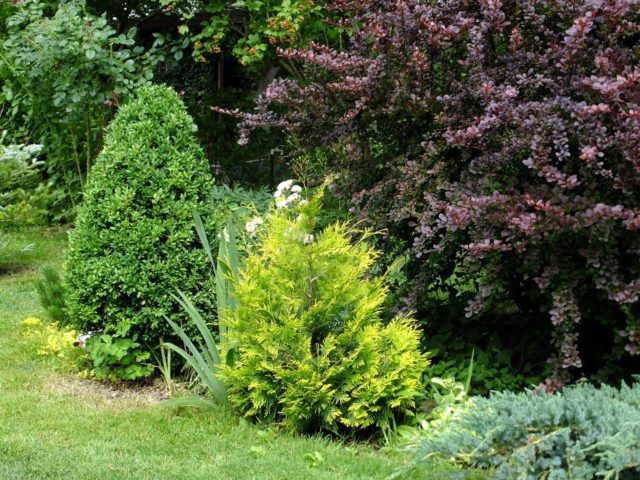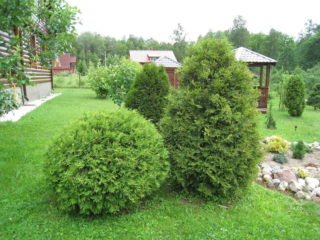Content
A representative of the Cypress family, the western thuja became the progenitor of numerous breeding varieties created for ornamental gardening. Thuja Yellow Ribbon is the most popular cultivar with exotic colored needles. Due to its high winter hardiness, the ornamental plant is used in landscape design in all climatic zones of Russia.
Description of thuja Yellow Ribbon
A low pyramidal tree with a dense dense crown, with 2 or whiter tops. The height of the thuja Yellow Ribbon is up to 2.5 m, the volume is 0.8 m. This is an indicator of a 15-year growing season. Western thuja grows slowly, adding 12 cm in height and 8 cm in width throughout the year. The plant is perennial, with a biological lifespan of 30-35 years.
External description of thuja western Yellow Ribbon (pictured):
- The crown is dense, compact, the trunk is even, straight with tightly pressed, short, strong skeletal branches.Young shoots with powerful branching at the ends, the tops seem to be turned outward, located parallel to the central trunk. The bark of young shoots is olive-colored, while that of long-term shoots is dark gray.
- The needles have a scaly structure, small - up to 2.5 cm in length, densely located, tightly pressed to the shoot. The color of the needles is bright orange, at the ends of the shoots they are light yellow; by mid-summer the needles turn green, and in autumn they turn dark red.
- The cones are brown, scaly, formed in small quantities, length – 13 cm. The seeds are small, beige, equipped with lionfish.
- The roots are thin, numerous, deepened to 60 cm, forming a compact intertwined system.
Thuja western Yellow Ribbon resists strong winds well and is not afraid of drafts. Reacts calmly to gas and smoke pollution in the environment.
The use of thuja Yellow Ribbon in landscape design
Western thuja Yellow Ribbon is characterized by a highly decorative appearance. A distinctive feature of thuja, which makes it in demand for gardeners and professional designers, is its variability of color and the correct compact crown. Thuja does not create problems with rooting and care, can withstand temperatures down to -38 0C, tolerates shearing well, and keeps its shape for a long time. All these advantages have made the western thuja Yellow Ribbon a favorite in ornamental gardening almost throughout Russia. Several photos of the use of thuja Yellow Ribbon in landscape design are presented below.
Western thuja in the foreground in a group planting with ornamental shrubs.
In a composition with large-sized and dwarf conifers.
Thuja in combination with flowering plants.
As a tapeworm in the center of a flower bed.
Western thuja as an accent in the foreground of the composition. 7
Thuja as a hedge.
Peculiarities of reproduction of western thuja Yellow Ribbon
Western thuja Yellow Ribbon reproduces in a generative and vegetative way. The seeds of the cultivar completely retain the characteristics of the mother plant. Seeds are collected in mid-autumn, and the material is planted in the spring in a mini-greenhouse or container. In the fall, the seedlings are planted and after 3 years they are planted on the site.
Propagation by cuttings of western thuja is a less productive method, but faster. Cuttings are harvested from the middle of last year's shoots in early August. The material is placed in a fertile substrate, creating a greenhouse effect. If the cuttings are planted on the site, shelter is necessary for the winter. If in a pot, then the cuttings of the western thuja are lowered into the basement. In spring, thuja is planted on the site.
Thuja Yellow Ribbon can be propagated using layering. The lower shoot is dug in in the spring and covered for the winter. At the beginning of next summer, it will be seen how many plots have been created; they will be cut and planted in a permanent place.
Landing rules
To plant western thuja Yellow Ribbon, take a seedling no younger than 3 years old; the material purchased from a specialized nursery is pre-disinfected. If a thuja seedling is grown independently, before planting, the root system is dipped in a manganese solution for 5 hours, then in a growth stimulator for the same time.
Recommended timing
The planting time of thuja Yellow Ribbon depends on the climate zone. In regions with temperate climates, autumn planting is not considered. Thuja is planted on the site in the spring, approximately in May, when the earth has warmed up to +7 0C. In areas with a warm climate, planting work is carried out in spring (around mid-April) and early autumn (early September).
Site selection and soil preparation
According to gardeners, Thuja Yellow Ribbon has a bright decorative crown only with sufficient lighting. In the shade, the growing season slows down, the crown becomes insufficiently dense, so choose a planting site without shading, on the south or east side, protected from drafts.
Western thuja prefers slightly alkaline or neutral soils, light, drained, and enriched with oxygen. Loamy or sandy loam soil is suitable; close proximity to groundwater is not allowed. Over-watering of the root ball leads to bacterial infection, which is difficult to get rid of; the disease often leads to the death of the thuja.
Before planting, dig up the area, add dolomite flour, if the soil is acidic, add compost. Prepare a nutrient substrate for planting, mix sand, peat, turf soil in equal parts, add 200 g of ash and 150 g of urea per 10 kg of mixture.
Landing algorithm
3 days before planting, prepare a hole. The width of the recess is 10 cm larger than the root system, the depth is 0.7 m.
The sequence of work for planting thuja Yellow Ribbon:
- A drainage cushion is placed at the bottom, consisting of a lower layer of coarse fraction and an upper layer of fine fraction. Use gravel and brick chips.
- The nutrient mixture is divided into two parts, half is poured onto the drainage, and a cone-shaped mound is made.
- The seedling is installed in the center.
- Cover with the remaining nutrient substrate and soil.
- The tree trunk circle is compacted, watered, and mulched.
If there is a mass planting, the interval between seedlings is 2.5-3 m.
Rules for growing and care
The rules for growing western thuja Yellow Ribbon include watering, fertilizing and pruning, and crown formation.
Watering schedule
Thuja Yellow Ribbon is a moisture-loving plant and requires sprinkling at any age. Mature plants have higher drought resistance than seedlings up to 5 years old. Watering depends on rainfall; if there is enough rainfall, the trees are not watered. Young thuja requires at least two waterings per week; mature trees are moistened 3-4 times a month with plenty of water. After planting and every spring, thuja Yellow Ribbon is mulched to retain moisture.
Top dressing
Nutrients when planting western thuja Yellow Ribbon are sufficient for 3 years of growth. Then in the spring, before sap flow, complex mineral products designed specifically for Cypress trees or Kemira universal fertilizer are applied. In mid-July, thuja is watered with an organic solution.
Trimming
Thuja Yellow Ribbon is pruned in the fourth year of the growing season; until this time the seedling does not need pruning. The natural shape of the crown is quite decorative, so it is often left unchanged. If the design plan provides for formation, the thuja tolerates the gardener’s intervention well, holds its shape for a long time, and quickly recovers. The photo shows a variant of the Western Thuja Yellow Ribbon haircut. In addition to the formation of the crown, sanitary pruning is carried out every spring, frozen and dry fragments are removed.
Preparing for winter
The older the Yellow Ribbon thuja, the higher the frost resistance index. An adult plant does not require crown cover; moisture-replenishing watering and increasing the layer of mulch are sufficient. A young thuja, without preliminary measures taken, may not tolerate a temperature drop to -30 0C. Preparing thuja for winter:
- The plant is spudded.
- Double the mulch layer, use peat mixed with sawdust, and sprinkle straw on top.
- The branches are tied together with rope and secured.
- The top is covered with insulating material.
In winter, a snowdrift is thrown over the tree trunk circle.
Pests and diseases
Western thuja varieties do not have high immunity. The plant is susceptible to a number of fungal infections. Thuja Yellow Ribbon is affected by the following diseases:
- late blight. The pathology develops due to prolonged waterlogging of the root ball; a fungal infection affects the entire plant. Get rid of the fungus with fungicides, reduce watering or replant it in another place;
- rust. The infection affects needles and young shoots; thuja is at risk up to four years of growing season. Eliminate the disease "Homo";
- death of shoot tips. The reason is a fungus. Fundazol is used to treat thuja.
Garden pests parasitizing Thuja Yellow Ribbon:
- moth caterpillars. To get rid of it, thuja is treated with Fumitox;
- spider mite Neutralize the insect with acaricides and conduct constant sprinkling;
- the weevil appears when the soil is highly acidic - destroy the parasite with insecticides and neutralize the soil;
- The main and most common pest is aphids; they get rid of them with a solution of laundry soap and spray the plant generously. If the measure is unsuccessful, they are treated with Karbofos, and anthills are removed from the area.
Conclusion
Thuja Yellow Ribbon is a selection variety of Western thuja. This is an evergreen crop with an unusual color of needles, which change color three times during the spring-summer period. Thuja Yellow Ribbon is unpretentious in care, responds well to haircuts, the growth of the crop is small, so the western thuja retains its shape for a long time. The winter-hardy plant is grown in all climatic zones of Russia.
















